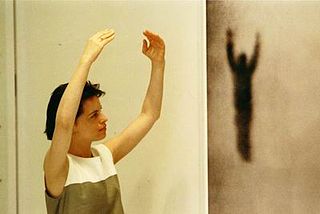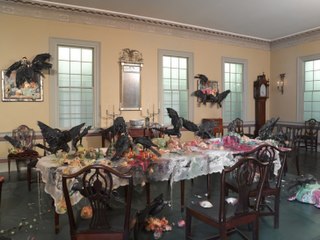
The Whitney Museum of American Art, known informally as "The Whitney", is a modern and contemporary American art museum located in the Meatpacking District and West Village neighborhoods of Manhattan in New York City. The institution was originally founded in 1930 by Gertrude Vanderbilt Whitney (1875–1942), a prominent American socialite, sculptor, and art patron after whom it is named.

Carol Bove is an American artist based in New York City. She lives and works in Brooklyn.
Rachel Harrison is an American visual artist known for her sculpture, photography, and drawing. Her work often combines handmade forms with found objects or photographs, bringing art history, politics, and pop culture into dialogue with one another. She has been included in numerous exhibitions in Europe and the US, including the Venice Biennale, the Whitney Biennial and the Tate Triennial (2009). Her work is in the collections of major museums such as The Museum of Modern Art, New York; Metropolitan Museum of Art, New York; Hirshhorn Museum and Sculpture Garden, Washington, D.C.; and Tate Modern, London; among others. She lives and works in New York.

Lynda Benglis is an American sculptor and visual artist known especially for her wax paintings and poured latex sculptures. She maintains residences in New York City, Santa Fe, New Mexico, Kastellorizo, Greece, and Ahmedabad, India.
Chakaia Booker is an American sculptor known for creating monumental, abstract works for both the gallery and outdoor public spaces. Booker’s works are contained in more than 40 public collections and have been exhibited across the United States, Europe, Africa, and Asia. Booker was included in the 2000 Whitney Biennial, received a Guggenheim Fellowship in 2005, and an American Academy of Arts and Letters Award for Art in 2001. Booker has lived and worked in New York City’s East Village since the early 1980s and maintains a production studio in Allentown, Pennsylvania.

Chryssa Vardea-Mavromichali was a Greek American artist who worked in a wide variety of media. An American art pioneer in light art and luminist sculpture, known for her neon, steel, aluminum and acrylic glass installations, she always used the mononym Chryssa professionally. She worked from the mid-1950s in New York City studios and worked since 1992 in the studio she established in Neos Kosmos, Athens, Greece.

Jessica Stockholder is a Canadian-American artist known for site-specific installation works and sculptures that are often described as "paintings in space." She came to prominence in the early 1990s with monumental works that challenged boundaries between artwork and display environment as well as between pictorial and physical experience. Her art often presents a "barrage" of bold colors, textures and everyday objects, incorporating floors, walls and ceilings and sometimes spilling out of exhibition sites. Critics suggest that her work is informed by diverse artistic traditions, including abstract expressionism, color field painting, minimalism and Pop art. Since her early career, they have noted in her work an openness to spontaneity, accident and marginality and a rejection of permanency, monetization and disciplinary conventions that Stephen Westfall characterized as an "almost shocking sense of freedom."

Katy Schimert is an American artist known for exhibitions and installations that meld disparate media into cohesive formal and conceptual visual statements arising out of personal experience, myth and empirical knowledge. She interweaves elements of fine and decorative arts, figuration and abstraction in densely layered drawings and sculpture that together suggest elliptical narratives or unfolding, cosmic events. Curator Heidi Zuckerman wrote that Schimert is inspired by "the places where the organized and the chaotic intersect—the scientific and the mythic, the known and the unknown, and the real and the imagined … she creates work that exists where, through fantasy, truth and beauty meet."
Alma Allen is an American sculptor. He lived and worked in Joshua Tree, California. He currently works in Tepotzlán, Mexico.

Charles Ross is an American contemporary artist known for work centered on natural light, time and planetary motion. His practice spans several art modalities and includes large-scale prism and solar spectrum installations, "solar burns" created by focusing sunlight through lenses, paintings made with dynamite and powdered pigment, and Star Axis, an earthwork built to observe the stars. Ross emerged in the mid-1960s at the advent of minimalism, and is considered a forerunner of "prism art"—a sub-tradition within that movement—as well as one of the major figures of land art. His work employs geometry, seriality, refined forms and surfaces, and scientific concepts in order to reveal optical, astronomical and perceptual phenomena. Artforum critic Dan Beachy-Quick wrote that "math as a manifestation of fundamental cosmic laws—elegance, order, beauty—is a principle undergirding Ross’s work … [he] becomes a maker-medium of a kind, constructing various methods for sun and star to create the art itself."
Rachel Lachowicz is an American artist based in Los Angeles, California. She is primarily recognized for appropriating canonical works by modern and contemporary male artists such as Carl Andre and Richard Serra and recreating them using red lipstick.

Michal Rovner, also known as Michal Rovner Hammer, is an Israeli contemporary artist, she is known for her video, photo, and cinema artwork. Rovner is internationally known with exhibitions at major museums, including the Louvre (2011) and the Whitney Museum of American Art (2002).

Simone Leigh is an American artist from Chicago who works in New York City in the United States. She works in various media including sculpture, installations, video, performance, and social practice. Leigh has described her work as auto-ethnographic, and her interests include African art and vernacular objects, performance, and feminism. Her work is concerned with the marginalization of women of color and reframes their experience as central to society. Leigh has often said that her work is focused on “Black female subjectivity,” with an interest in complex interplays between various strands of history. She was named one of the 100 most influential people in the world by Time magazine in 2023.

Valerie Hegarty is an American painter, sculptor, and installation artist. She is known for irreverent, often critical works that replicate canonical paintings, furnishings, and architectural spaces from American or personal history undergoing various processes of transformation. Hegarty most often portrays her recreations in meticulously realized, trompe l’oeil states of decay, ruin, or physical attack related to their circumstances. Her work examines American historical themes involving colonization, slavery, Manifest Destiny, nationalism, art-historical movements and their ideological tenets, romantic conceptions of nature, and environmental degradation. Sculpture critic Robin Reisenfeld wrote that among other things, Hegarty's art is "informed by 19th-century American landscape painting as an expression of the sublime, as well as by the manufacturing of two-dimensional 'masterworks' to be destroyed in three-dimensional fashion in order to evoke entropic forces of growth and decay."

Arlene Shechet is an American sculptor known for her inventive, gravity-defying arrangements and experimental use of diverse materials. Critics describe her work as both technical and intuitive, hybrid and polymorphous, freely mixing surfaces, finishes, styles and references to create visual paradoxes. Her abstract-figurative forms often function as metaphors for bodily experience and the human condition, touching upon imperfection and uncertainty with humor and pathos. New York Times critic Holland Cotter wrote that her career "has encompassed both more or less traditional ceramic pots and wildly experimental abstract forms: amoebalike, intestinal, spiky, sexual, historically referential and often displayed on fantastically inventive pedestals … this is some of the most imaginative American sculpture of the past 20 years."
Olga Balema is a Ukrainian-born American artist and sculptor. One of the major concerns of her work is form, another material. Another is paying attention to where and how things go into a space. Sometimes the work can be called site respondent, other times it responds only to itself. Her practice presents mundane materials in evocative forms. She is based in New York City, New York.

Gina Beavers is an American artist based in the New York area. She first gained attention in the early 2010s for thickly painted, relief-like acrylic images of food, cosmetics techniques and bodybuilders appropriated from Instagram snapshots and selfies found using hashtags such as #foodporn, #sixpack and #makeuptutorial. Her later work has continued to recombine these recurrent subjects, as well as explore memes, irreverent conflations of genres or art history and kitsch, identity, fandom and celebrity-worship. In 2019, New York Times critic Martha Schwendener described her paintings as "canny statements on contemporary bodies, beauty and culture … [that] tackle the weirdness of immaterial images floating through the ether, building them up into something monumental, rather than dismissing them."

Joanna Pousette-Dart is an American abstract artist, based in New York City. She is best known for her distinctive shaped-canvas paintings, which typically consist of two or three stacked, curved-edge planes whose arrangements—from slightly precarious to nested—convey a sense of momentary balance with the potential to rock, tilt or slip. She overlays the planes with meandering, variable arabesque lines that delineate interior shapes and contours, often echoing the curves of the supports. Her work draws on diverse inspirations, including the landscapes of the American Southwest, Islamic, Mozarabic and Catalan art, Chinese landscape painting and calligraphy, and Mayan art, as well as early and mid-20th-century modernism. Critic John Yau writes that her shaped canvasses explore "the meeting place between abstraction and landscape, quietly expanding on the work of predecessors", through a combination of personal geometry and linear structure that creates "a sense of constant and latent movement."

Harriet Korman is an American abstract painter based in New York City, who first gained attention in the early 1970s. She is known for work that embraces improvisation and experimentation within a framework of self-imposed limitations that include simplicity of means, purity of color, and a strict rejection of allusion, illusion, naturalistic light and space, or other translations of reality. Writer John Yau describes Korman as "a pure abstract artist, one who doesn’t rely on a visual hook, cultural association, or anything that smacks of essentialization or the spiritual," a position he suggests few post-Warhol painters have taken. While Korman's work may suggest early twentieth-century abstraction, critics such as Roberta Smith locate its roots among a cohort of early-1970s women artists who sought to reinvent painting using strategies from Process Art, then most associated with sculpture, installation art and performance. Since the 1990s, critics and curators have championed this early work as unjustifiably neglected by a male-dominated 1970s art market and deserving of rediscovery.
Bonnie Rychlak is an American artist, curator, and writer. She is known for her wax sculptures representing functional urban forms and actions of evacuation and for her practice of carving, casting wax, and melting it into fabric. Influenced by the work of Eva Hesse and the encaustic paintings of Brice Marden and Jasper Johns, she employs wax as a medium for sculpture in its own right rather than simply as a transition to being cast in bronze.

















